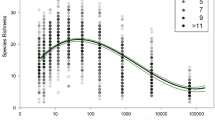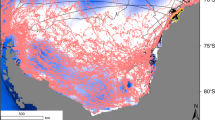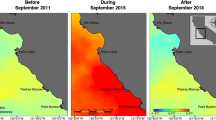Abstract
The West Antarctic Peninsula (WAP) is a hotspot of recent rapid regional warming and ice loss1. The WAP sea surface freezes each winter to form a ‘fast-ice’ skin that can reduce iceberg drift and collisions between their keels and the sea bed, in what is termed scouring. Scouring disturbance is thus inversely correlated with fast-ice duration2. We examined long-term records of fast ice, ice scour and mortality of benthos around Rothera research station (WAP) to determine whether there is a biological response from the sea bed coincident with fast-ice changes. Here we show that the duration of fast ice at Rothera has significantly decreased by >5 d yr−1 over 25 years and that this is strongly correlated with increased ice scour and mortality of benthos in the shallows. The number of experimental markers at Rothera crushed by iceberg scouring increased over the past decade. We found that survival of one of the most common shallow species3, the bryozoan Fenestrulina rugula, is linked to ice-scour frequency and has markedly decreased over the past 12 years. The chance of colonies reaching two years old, the age at which they typically begin to sexually reproduce, has halved since 1997. These findings suggest that increased scouring of the sea bed has led to higher benthic mortality, with implications for the region’s biodiversity.
This is a preview of subscription content, access via your institution
Access options
Subscribe to this journal
Receive 12 print issues and online access
$209.00 per year
only $17.42 per issue
Buy this article
- Purchase on Springer Link
- Instant access to full article PDF
Prices may be subject to local taxes which are calculated during checkout



Similar content being viewed by others
References
Turner, J. et al. Antarctic Climate Change and the Environment (SCAR, 2009).
Smale, D. A. et al. Ice scour disturbance in Antarctic waters. Science 321, 371 (2008).
Barnes, D. K. A. & Clarke, A. The ecology of an assemblage dominant; the encrusting bryozoan Fenestrulina rugula. Invert. Biol. 117, 331–340 (1998).
Stammerjohn, S. E. et al. Sea ice in the western Antarctic Peninsula region: Spatio-temporal variability from ecological and climate change perspectives. Deep-Sea Res. I 55, 2041–2058 (2008).
Thomas, D. N. Frozen Oceans (Natural History Museum, 2004).
Montes-Hugo, M. et al. Recent changes in phytoplankton communities associated with rapid regional climate change along the Western Antarctic Peninsula. Science 323, 1470–1473 (2009).
Trivelpiece, W. Z. et al. Variability in krill biomass links harvesting and climate warming to penguin population changes in Antarctica. Proc. Natl Acad. Sci. USA 108, 7625–7628 (2011).
De Broyer, C. & Danis, B. SCAR-MarBIN: The Antarctic Marine Biodiversity Information Network; available at http://www.scarmarbin.be/.
Peck, L. S, Webb, K. & Bailey, D. Extreme sensitivity of biological function to temperature in Antarctic marine species. Funct. Ecol. 18, 625–630 (2004).
Brown, K. et al. Links between the structure of an Antarctic shallow-water community and ice impact frequency. Oecologia 141, 121–129 (2004).
Gutt, J. & Piepenburg, D. Scale dependent impact on diversity of Antarctic benthos caused by grounding of icebergs. Mar. Ecol. Prog. Ser. 253, 77–83 (2003).
Conlan, K. E. & Kvitek, R. G. Recolonization of ice scours on an exposed Arctic coast. Mar. Ecol. Prog. Ser. 286, 21–42 (2005).
Barnes, D. K. A. et al. Scott’s collections help reveal accelerating marine life growth in Antarctica. Curr. Biol. 21, R147–R148 (2011).
Barnes, D. K. A. et al. Slow growing Antarctic bryozoans show growth to increase over 20 years and be anomalously high in 2003. Mar. Ecol. Prog. Ser. 314, 187–195 (2006).
Meredith, M. & King, J. Rapid climate change in the ocean west of the Antarctic Peninsula during the second half of the 20th century. Geophys. Res. Lett. 32, L19604 (2005).
Shuman, C. A. et al. 2001–2009 elevation and mass losses in the Larsen A and B embayments, Antarctic Peninsula. J. Glaciol. 57, 737–754 (2011).
Orr, J. C. et al. Anthropogenic ocean acidification over the twenty-first century and its impact on calcifying organisms. Nature 437, 681–686 (2005).
Smale, D. A. et al. Benthic community response to iceberg scouring at an intensely disturbed shallow water site at Adelaide Island, Antarctica. Mar. Ecol. Prog. Ser. 355, 85–94 (2008).
Acknowledgements
We thank all recorders of fast-ice conditions from 1986 to 2010 and drivers of the Rothera Time Series, A. Clarke and M. Meredith. We also thank diving staff that have participated in the ice-scour project since its inception and remember K. Brown, who died in pursuit of understanding ice scour and its influence on seabed biology. Finally, we thank M. Eléaume for very helpful comments leading to a better manuscript.
Author information
Authors and Affiliations
Contributions
Project planning, fast-ice duration and biological data collection, data analysis, writing—D.K.A.B. Diving surveys, fast-ice duration and ice-scour data collection—T.S.
Corresponding author
Ethics declarations
Competing interests
The authors declare no competing financial interests.
Supplementary information
Supplementary Information
Supplementary Information (PDF 270 kb)
Rights and permissions
About this article
Cite this article
Barnes, D., Souster, T. Reduced survival of Antarctic benthos linked to climate-induced iceberg scouring. Nature Clim Change 1, 365–368 (2011). https://doi.org/10.1038/nclimate1232
Received:
Accepted:
Published:
Issue Date:
DOI: https://doi.org/10.1038/nclimate1232
This article is cited by
-
Metabarcoding the Antarctic Peninsula biodiversity using a multi-gene approach
ISME Communications (2022)
-
DNA barcoding provides insights into Fish Diversity and Molecular Taxonomy of the Amundsen Sea
Conservation Genetics Resources (2022)
-
Exploration of an ice-cliff grounding zone in Antarctica reveals frozen-on meltwater and high productivity
Communications Earth & Environment (2021)
-
Submarine landslides triggered by iceberg collision with the seafloor
Nature Geoscience (2021)
-
Glacial melt disturbance shifts community metabolism of an Antarctic seafloor ecosystem from net autotrophy to heterotrophy
Communications Biology (2021)



